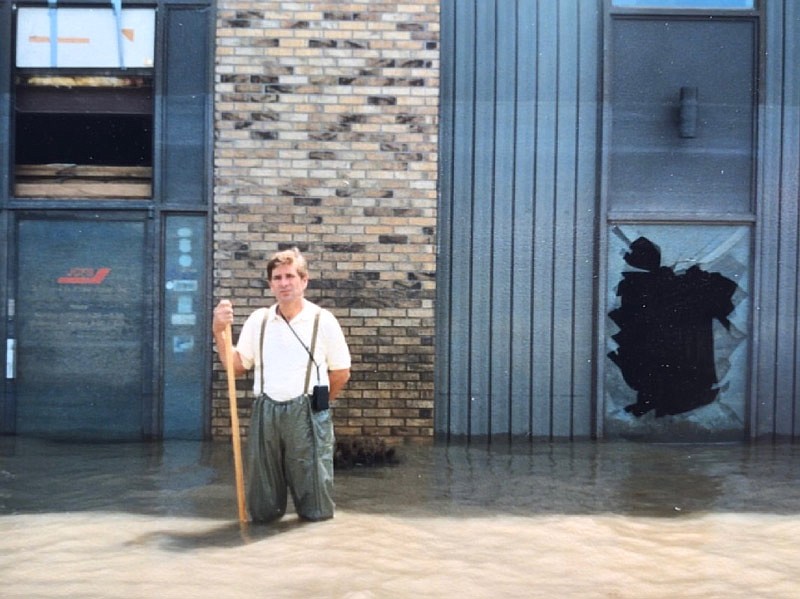Editor's Note: This column is the third in a three-part series about the history of the Jefferson City airport.
Flooding was the big issue from 1986-2019, though other interesting and important events also occurred.
The Missouri River was on the rise again, following 10 days and more than 6.5 inches of rain, the News Tribune reported Oct. 2, 1986. The airport, as well as the 460 residents of Cedar City, was evacuated before the river crested at 32.6 feet Oct. 5, 1986.
It's a relationship the airport has had with the Missouri River since the first airport north of the river opened in 1929.
In 1971, the Jefferson City Flying Service was founded by Jim Dawson and Darold Kirtlink, providing fuel, hangars, flight instruction and maintenance of aircraft. Terry Rackers and Bill Ward bought the flying service in 1974. Stan Kroenke and Ben Ames joined later. In 2000, the service was sold to Richard Kampeter, Laron Haslag and Grant Shorthose. Shorthose has been with the flying service since 1985. Other personnel include Steve Wilbers and Gary Baitinger, who started in 1987 and 1988, respectively.
The celebration of the Jefferson City airport's 40th anniversary July 30, 1988, included a first-time parachute jump by Mayor Louis Gardner, the city's first female mayor.
The flood threat returned in early July 1993.
The headline, "US 63 closed, sewage woes rose" ran July 27, 1993, in the Jefferson City Post Tribune. Attempting to check on the airport, Jefferson City Flying personnel turned back when they noticed water coming through the U.S. 54 barricades. Thirty minutes later, the road was closed and soon washed out. After cresting July 30, 1993, at 38.65 feet, the river was out of its banks 49 days until Aug. 20, 1993. July (13.38 inches) and 1993 (66.13 inches) were the wettest on record.
At the river's crest, 10 feet of water covered the airport. Damage was extensive. Lumber pallets floating from Great Central Lumber threatened to destroy the flying service building. The interior of most buildings at the airport had to be gutted and redone.
Between great floods, a Russian AN-24, which had violated multiple airspaces coming from Maine, landed at 6:24 p.m. May 26, 1994, in Jefferson City. Many government agencies, including the Department of Defense and FBI, were interested in this crew, which spoke little English. The FBI requested the flying service disable the airplane by letting the air out of the tires. Rackers said they could not do that. Instead, they locked the propeller with a chain.
The Russian crew said they were transporting a YAK acrobatic plane to California. However, law enforcement was skeptical. The crew stayed in Jefferson City for several weeks before being allowed to fly on to South America.
On May 16, 1995, 2.8 inches of rain fell overnight bringing the river level to 29.1 feet. By this time, evacuation plans had become a routine part of doing business for most airport tenants.
When the river crested May 19, 1995, at 33.05 feet, the newspaper reported the nearby sewage treatment plant was as useless as during the 1993 flood, dumping the 7.5 million gallons of daily raw sewage directly into the river. As with evacuation plans, cleanup plans also were becoming routine and with each cleanup the airport saw modest improvements.
Dealing with the chaos created at the airport by the back-to-back floods was Airport Manager Ron Craft, who came to the airport in 1996, after working at St. Louis Lambert and St. Louis Spirit in airport operations. Craft began his aviation career as an air traffic controller in 1979 in Alton, Illinois.
John Drainer retired in 1996 after serving as tower chief since 1973. Drainer was a U.S. Navy air traffic controller for 20 years before coming to Jefferson City. He recruited his brother-in-law, Mel Jones, who started in 1975 and retired in 2018 with 61 years' experience as an air traffic controller. Jones also served 20 years in the Navy.
Air traffic was closed by the FAA for three days, following the Sept. 11, 2001, terrorist attacks, when terrorists hijacked four airliners and crashed them into the World Trade Center, the Pentagon and a field in Pennsylvania. Since the start of aviation in the United States, there had never been a complete shutdown of airspace. After reopening, things quickly got back to normal.
The Jefferson City airport was under water again in June 2019. The river crested June 5 at 33.44 feet. This flood spelled the end of Nick's Airport Restaurant and the present terminal building. The city is currently exploring options to replace the terminal building.
Despite the turmoil caused by flooding over the years, the local airport is not just surviving but thriving. The airport is vital for continued economic development in Jefferson City, and the airport is recognized as one of finest airports of its size in the country.
Terry Rackers worked at the Jefferson City airport from 1960-2000. He was co-owner and president of Jefferson City Flying Service from 1974-2000. From 1977-2017 he was co-owner and president of Central Missouri Aviation in Columbia. He flew throughout the United States, the Caribbean and Europe.

